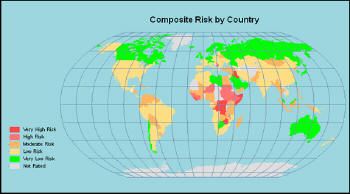 Location
intelligence technology is frequently used to analyze risks in new
markets. The geography being analyzed is often a trade area or a
specific market. In the case of The
PRS Group, the focus encompasses more than 160 countries. As more
companies look to establish international operations, assessing
potential markets must include gauging the risks in the countries being
considered. That’s where The PRS Group (PRS) comes in. Examination of a
wide variety of factors is necessary to undertake this type of market
assessment. Those factors include the following.
Location
intelligence technology is frequently used to analyze risks in new
markets. The geography being analyzed is often a trade area or a
specific market. In the case of The
PRS Group, the focus encompasses more than 160 countries. As more
companies look to establish international operations, assessing
potential markets must include gauging the risks in the countries being
considered. That’s where The PRS Group (PRS) comes in. Examination of a
wide variety of factors is necessary to undertake this type of market
assessment. Those factors include the following.- Political risks: Who is in charge; is this likely to change?
- Financial transfer issues: Is the currency soft or difficult to convert to hard currency?
- Investment issues: Is local majority ownership required; can you repatriate profits?
- Infrastructure: Does the country have the components needed and of the right quality?
- Labor: Is hiring a long-term commitment, not tied to performance?
Methodology #1: Political Risk Services
The Political Risk Services methodology is based on the Coplin-O’Leary system developed during 20 years of research by Professors William D. Coplin and Michael K. O’Leary at Syracuse University. It provides a standardized method of calculating a letter grade based on factors seen in two timeframes, 18 months and five years. The objective is to offer an understanding of near-term and longer-term risk in a country. This type of assessment is valid and useful even if a company has been operating in a country for some time, as things can change. The letter grades apply to each of the categories below.
18 month factors:
- Turmoil
- Equity restrictions
- Operations restrictions
- Taxation discrimination
- Repatriation restrictions
- Exchange controls
- Tariff barriers
- Other import barriers
- Payment delays
- Fiscal and monetary expansion
- Labor policies
- Foreign debt
- Turmoil
- Investment restrictions
- Trade restrictions
- Domestic economic problems
- International economic problems
Creating your own assessment
PRS provides a set of steps for you to create you own assessment. The company even offers a “standard worksheet” to help you along. These steps will allow you a first cut analysis, but PRS has access to a wide range of data that are difficult to collect and may, therefore, yield a more comprehensive assessment.
Here are some examples of letter grades PRS has assigned to several countries.
Grade A+ countries for global financial transfer risk
- Canada
- The Netherlands
- Norway
- Singapore
- Switzerland
- Myanmar
- Venezuela
- Zimbabwe
The ICRG system published by PRS is a numerical rating system that scores a multitude of components for political, economic and financial risk to determine a rating for each category. These three ratings are then used to determine an overall composite rating, a number from 0 to 100 (zero being an extremely high risk, 100 being the lowest risk).
Examples of very low risk countries
- Norway 92.3
- Luxembourg 90.0
- Switzerland 89.8
- Brunei 89.0
- Singapore 88.5
- Liberia 48.8
- Congo Democratic Republic 48.5
- Iraq 46.3
- Zimbabwe 43.0
- Somalia 15.5
 |
Although the process of evaluating a country is different than evaluating a U.S. market or trade area, they are the same in so far as the process is designed to create an understanding of whether success can be achieved in a given environment. If you are going to be in international markets, you must be doing this type of assessment and on a regular basis. If you just go ahead and try doing business without really understanding in any part of the world, some very unpleasant and expensive surprises may await you.
Data Sources
PRS accesses local analysts (in the country), newspapers, international financial statistics and the following list of sources to provide at least 15 categories of information and 39 financial variables. This list, taken from the bibliography on sources of data, provides insight into the types of sources they use.
- Annual Report on Exchange Arrangements and Exchange Restrictions. Washington, DC: International Monetary Fund. Annual.
- Chiefs of State and Cabinet Members of Foreign Governments. Springfield, VA: National Technical Information Service. Monthly.
- Exchange Arrangements and Exchange Restrictions. Washington, DC: International Monetary Fund. Annual.
- National Trade Data Bank. Washington DC: US Department of Commerce. Monthly.
- International Financial Statistics. Washington, DC: International Monetary Fund. Monthly.
- OECD Economic Outlook. Paris: Organization for Economic Cooperation and Development. Semiannual.
- OECD Economic Surveys. Paris: Organization for Economic Cooperation and Development. Periodical.
- PRS's research data files
- PRS's network of country and political risk analysts
- World Almanac and Book of Facts. New York: Newspaper Enterprise Association. Annual.
- World Development Indicators. Washington, DC: World Bank. Annual.
- World Factbook. Washington, DC: Central Intelligence Agency. Annual.
- World Population Data Sheet. Washington, DC: Population Reference Bureau. Annual.